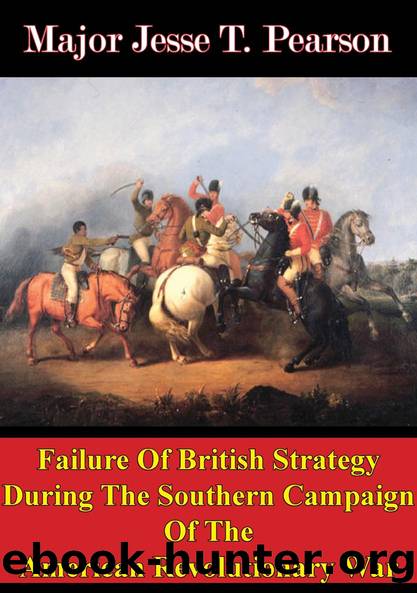Failure Of British Strategy During The Southern Campaign Of The American Revolutionary War by Major Jesse T. Pearson

Author:Major Jesse T. Pearson [Pearson, Major Jesse T.]
Language: eng
Format: epub
ISBN: 9781786252203
Barnesnoble:
Publisher: Golden Springs Publishing
Published: 2015-11-06T00:00:00+00:00
CHAPTER 5 â GREENEâS CAMPAIGN
The fourth factor that contributed to the failure of British strategy in the south was patriot General Nathanael Greeneâs campaign in 1780 and 1781. This chapter examines Greeneâs use of mobile warfare against Cornwallisâs army. Next, it explores Greeneâs effectiveness in rallying the support of local leaders. Following that, this chapter analyzes his use of patriot militias against British forces. Additionally, it examines Greeneâs battles with the British at Cowpens and Guilford Courthouse and Cornwallisâs withdrawal from the backcountry in April 1781. Lastly, it surveys Greeneâs final battles to destroy British backcountry garrisons during the second half of 1781.
On 14 October 1780, General George Washington convinced Congress to accept his nomination of General Nathanael Greene to command the Southern Department. Greene was a Rhode Islander who had never been farther south than Maryland. He brought important leadership and administrative skills to the command. Greene achieved a decisive victory against the British in the south through superior strategy. Cornwallis and his army permanently abandoned the backcountry less than five months after Greene's arrival in the south.
Greene was born to a middle class Quaker family in Potowomut, Rhode Island on 27 July 1742. His father was the spiritual leader of the surrounding East Greenwich Quaker community. He taught his son to glorify God by living an exemplary, sober, and useful life. Greene was an avid reader who devoured Euclid, Locke, and Swift. He also suffered from asthma. A childhood knee injury developed into a limp that stayed with him throughout his life.
In 1770, Greene moved to Coventry, Rhode Island and took charge of the family ironworks. The business manufactured chains, anchors, and other items used in shipping. It was here that Greene began to develop his exceptional administrative skills. He also displayed a talent for detailed planning and problem solving. One of Greeneâs staff officers later wrote, âNo man was more familiarized to dispassionate and minute research than was General Greene.â{152}
In 1774, Greeneâs religious community expelled him for volunteering for the Rhode Island militia. Greeneâs superiors quickly recognized his talent and promoted him to brigadier general. Greene met Washington in July 1775 and the two men established a close personal relationship that lasted throughout the war. Washington's aide wrote that Greene âis beyond doubt a first-rate military genius, and one in whose opinions the General places the utmost confidence.â{153}
On 17 April 1776, Greene assumed responsibility for the defense of Long Island, New York. He participated in every major battle that Washington fought over the next three years. Greene crossed the Delaware River with Washington on 25 December 1776 and commanded troops in the patriot victory at Trenton, New Jersey. He spent the winter of 1777 with Washington at Valley Forge, Pennsylvania and the winter of 1778 with him at Morristown, New Jersey. Greene also faced Cornwallis while commanding troops at three northern battlefields: Brandywine, Germantown, and Monmouth Court House.
During the winter of 1777, Washington's army was close to starvation. General Thomas Mifflin was Washingtonâs quartermaster general. He was responsible for providing for the armyâs logistical support and had clearly failed in his duties.
Download
This site does not store any files on its server. We only index and link to content provided by other sites. Please contact the content providers to delete copyright contents if any and email us, we'll remove relevant links or contents immediately.
In Cold Blood by Truman Capote(3311)
The Innovators: How a Group of Hackers, Geniuses, and Geeks Created the Digital Revolution by Walter Isaacson(2847)
Steve Jobs by Walter Isaacson(2836)
All the President's Men by Carl Bernstein & Bob Woodward(2329)
Lonely Planet New York City by Lonely Planet(2172)
And the Band Played On by Randy Shilts(2131)
The Room Where It Happened by John Bolton;(2104)
The Poisoner's Handbook by Deborah Blum(2093)
The Murder of Marilyn Monroe by Jay Margolis(2059)
The Innovators by Walter Isaacson(2056)
Lincoln by David Herbert Donald(1945)
A Colony in a Nation by Chris Hayes(1881)
Under the Banner of Heaven: A Story of Violent Faith by Jon Krakauer(1750)
Amelia Earhart by Doris L. Rich(1650)
The Unsettlers by Mark Sundeen(1647)
Being George Washington by Beck Glenn(1623)
Birdmen by Lawrence Goldstone(1621)
Dirt by Bill Buford(1612)
Zeitoun by Dave Eggers(1593)
